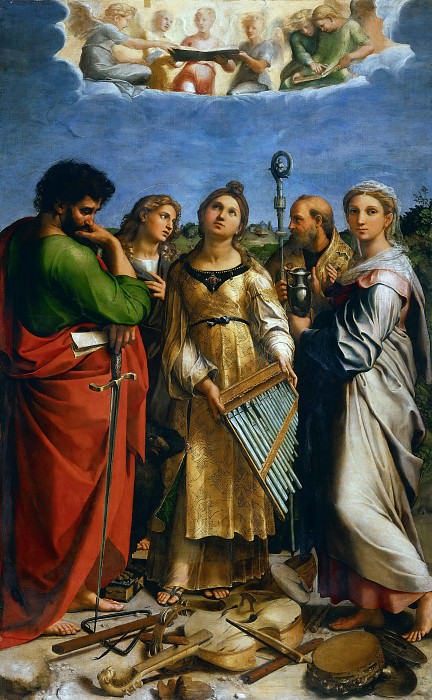Saint Cecilia with Saints Paul, John the Evangelist, Augustine, and Mary Magdalene Raphael (1483-1520)
Raphael – Saint Cecilia with Saints Paul, John the Evangelist, Augustine, and Mary Magdalene
Edit attribution
Download full size: 2591×4200 px (3,3 Mb)
Painter: Raphael
Location: National Art Gallery (Pinacoteca nazionale Bologna), Bologna.
The amazing time of the Renaissance gave history many brilliant sculptors and artists. Remarkably, the talented people of the time possessed precisely the versatile gift of painting, sculpture, graphics, and, at times, architecture. The genius of Raphael more than 5 centuries admires images of the beautiful man, the embodiment of the concept of harmonious beauty of life. Portraits and multi-figured compositions are distinguished by their originality and reveal all the best and meaningful things inherent in the personality.
Description of Raphael Santi’s painting "Saint Cecilia"
The amazing time of the Renaissance gave history many brilliant sculptors and artists. Remarkably, the talented people of the time possessed precisely the versatile gift of painting, sculpture, graphics, and, at times, architecture. The genius of Raphael more than 5 centuries admires images of the beautiful man, the embodiment of the concept of harmonious beauty of life.
Portraits and multi-figured compositions are distinguished by their originality and reveal all the best and meaningful things inherent in the personality. The master’s architectural talent can be felt in the conciseness and orderliness of thought in his best pictorial works.
"Saint Cecilia" was painted by Raphael at the request of Cardinal Lorenzo Pucci for the family chapel in Bologna. The composition brings to the forefront the figure of Caecilia, whose spiritualized face is raised toward heaven. The six singing angels attract the eye with the amazing expressiveness of their faces and figures. The artist has succeeded in conveying a moment of revelation, where the frozen Caecilia stands out against the background of her companions, whose gazes are directed at worldly affairs.
The picture is painted in warm golden-brown tones where only the monumental figure of Saint Paul stands out with a green color spot and creates an additional accent in the overall composition. The harmony of the images is achieved by wavy lines that create intertwined streams. These are folds of clothes and contours of figures, outlines of heavenly limits with singing angels. The integrity and completeness of the painting create a special world that one wants to gaze into, finding more and more details.
Кому понравилось
Пожалуйста, подождите
На эту операцию может потребоваться несколько секунд.
Информация появится в новом окне,
если открытие новых окон не запрещено в настройках вашего браузера.
You need to login
Для работы с коллекциями – пожалуйста, войдите в аккаунт (open in new window).

















You cannot comment Why?
Above the earthly figures, a group of angels are gathered in a luminous celestial setting. Some are shown singing or playing musical instruments, while others are looking down at the saints below, possibly contemplating the divine music Cecilia represents. The presence of these angelic choruses reinforces the heavenly and spiritual nature of the scene.
The subtexts of the painting revolve around the glorification of music and its connection to the divine. Saint Cecilias association with music is evident through her instrument and her rapturous gaze, suggesting a spiritual experience through sound. The surrounding saints represent different facets of Christian faith and devotion. Saint Paul embodies the strength of faith and missionary zeal, Saint John represents divine love and prophecy, Saint Augustine signifies theological wisdom, and Mary Magdalene represents repentance and devotion. Together, they form a council of saints in veneration of Saint Cecilia and the heavenly music. The broken musical instruments scattered at the bottom of the painting could symbolize the superiority of celestial music over earthly endeavors or a tribute to Cecilias martyrdom, as she is said to have been martyred for her faith, her music possibly playing a role in her persecution. The overall composition conveys a sense of harmony, devotion, and the transcendent power of divine music.